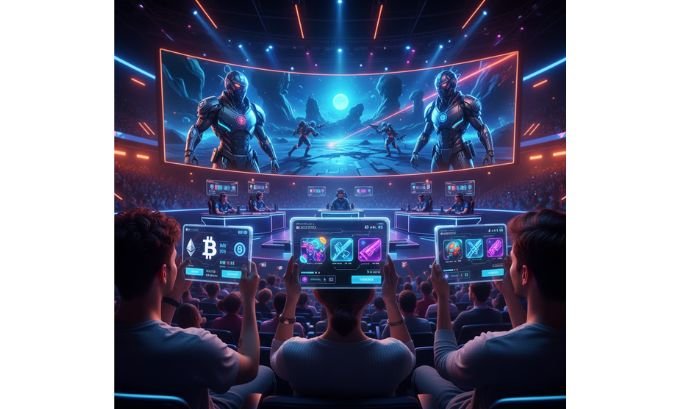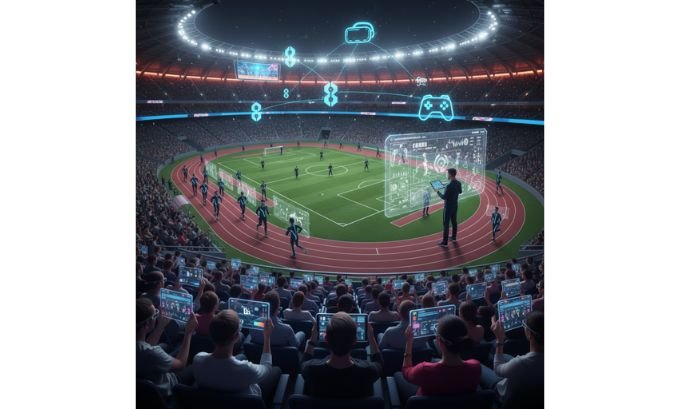The future of technology in sports is more than a buzzword—it’s a game-changer. From monitoring athlete performance to creating immersive fan experiences, technology is redefining every aspect of sports. Fans, players, and organizations now have tools that were unimaginable a decade ago, making the game smarter, faster, and more connected.
Today, we’ll explore how wearable tech, AI, IoT, VR, blockchain, esports, and ethical considerations are shaping the next generation of sports.
Table of Contents
Wearable Technology & Data Analytics: Your Smart Training Partner
Wearables are revolutionizing how athletes train, compete, and recover by providing real-time insights.
Wearable technology, like fitness trackers, smart clothing, and sensor-equipped shoes, collects data on speed, heart rate, calories burned, and movement efficiency. Coaches and athletes leverage this data to tailor workouts, prevent injuries, and enhance overall performance.

Example in Action:
NFL players use wearable sensors during practice to track acceleration, heart rate, and muscle strain. This data allows trainers to adjust drills and recovery plans to prevent injuries before they happen.
Strengths:
- Personalized insights for performance optimization
- Real-time injury prevention monitoring
- Quantifiable metrics to measure improvement
Areas for Improvement:
- High costs can limit access for smaller teams
- Risk of over-dependence on data over instinct
Artificial Intelligence & Machine Learning: Smarter Decisions, Better Wins
AI and ML analyze vast amounts of data to predict outcomes, optimize strategies, and reduce human error.
AI algorithms evaluate player statistics, historical game data, and even opponent behavior. Machine Learning automates video analysis, identifies patterns, and predicts injury risks, allowing coaches to make data-driven decisions.
Real-Life Scenario:
European soccer clubs, including Manchester City, utilize AI for player positioning and tactical planning. The technology predicts fatigue and injury risks, helping coaches make substitution decisions in real time.
Strengths:
- Enhances strategic decision-making
- Predicts player performance and health risks
- Automates tedious analysis for coaches and analysts
Areas for Improvement:
- Potential biases in AI models
- Requires continuous updates with fresh, accurate data
Internet of Things (IoT): Connecting the Game
IoT links players, stadiums, and equipment to create a smart, connected sports environment.
Smart stadiums leverage IoT to manage crowd flow, ticketing, and safety systems. Connected devices like smart balls, shoes, and wearables provide instant feedback on performance metrics.
Case Study:
At Tottenham Hotspur Stadium, IoT-enabled devices track real-time player positions, ball movements, and even fan engagement metrics. This not only enhances gameplay but ensures a seamless and safe fan experience.
Strengths:
- Real-time monitoring of players and fans
- Data-driven operational efficiency
- Enhanced engagement through interactive technologies
Areas for Improvement:
- Expensive infrastructure and maintenance
- Cybersecurity risks for connected devices
Virtual Reality & Augmented Reality: Experience Sports Like Never Before
VR and AR deliver immersive training for athletes and unforgettable experiences for fans.
VR for Athletes: Offers realistic simulations without physical strain, helping players practice high-risk maneuvers safely.
AR for Fans: Live statistics, 3D visualizations, and virtual tours create interactive, engaging viewing experiences.
Example:
Formula 1 drivers use VR simulators to practice tracks. Fans, meanwhile, can experience AR overlays during live broadcasts, visualizing player stats, ball speed, and tactical movements.
Strengths:
- Reduces injury risk through virtual training
- Enhances fan engagement with interactive content
- Bridges the gap between physical and digital sports worlds
Areas for Improvement:
- High cost and equipment requirements
- Potential sensory overload for users

Blockchain & Digital Transactions: Security and Transparency in Sports
Blockchain offers tamper-proof solutions for contracts, tickets, and digital collectibles.
Blockchain ensures secure contracts, anti-doping compliance, and transparent ticketing. NFTs (Non-Fungible Tokens) enable fans to own digital collectibles, such as highlight reels or unique moments.
Case Study:
NBA Top Shot allows fans to buy, sell, and trade unique highlight clips as NFTs. Blockchain ensures authenticity, ownership, and security in this digital marketplace.
Strengths:
- Immutable records for contracts and tickets
- Opens new revenue streams through NFTs
- Enhances fan engagement and loyalty
Areas for Improvement:
- High energy consumption for some blockchain networks
- Requires technological literacy for adoption
Esports & Digital Fan Engagement: The Next Big League

Esports blends competitive gaming with traditional sports, creating a massive global fan base.
Esports tournaments like the FIFA eWorld Cup attract millions of viewers worldwide. Streaming platforms, social media, and interactive apps let fans connect directly with players, creating global communities.
Integration Example:
Sports franchises, such as Paris Saint-Germain, now have esports teams. This crossover merges traditional sports branding with online gaming, expanding their fan base and digital reach.
Strengths:
- Expands audience globally
- Generates new digital revenue streams
- Builds interactive fan communities
Areas for Improvement:
- Intense schedules can lead to player burnout
- Regulatory frameworks are still evolving
Ethical, Economic, and Social Implications: Responsible Innovation
Quick answer: With great tech comes great responsibility.
Key Challenges:
- Privacy: Athlete biometric data and fan information must be safeguarded.
- Equity: Smaller teams may struggle to access advanced technologies.
- Sustainability: High-tech operations can consume significant energy.
Best Practices:
- Implement strong data privacy measures
- Promote equitable access to technology
- Monitor and reduce environmental impact
If you want to explore the future of technology in sports in even more depth, you can check out these insightful articles on GoGoNihon.jp.net, techbullion.in and MindJournal.co
Comparison Table: Technologies Shaping Sports Today
| Technology | Purpose | Benefits | Challenges |
| Wearables & Data Analytics | Athlete monitoring | Personalized training, injury prevention | Cost, over-reliance on data |
| AI & ML | Strategy & predictions | Smarter decisions, injury forecasting | Data bias, ethical concerns |
| IoT | Connected equipment & venues | Real-time tracking, fan engagement | Expensive, cybersecurity risks |
| VR & AR | Training & fan immersion | Safe practice, interactive experiences | High cost, accessibility |
| Blockchain | Contracts & collectibles | Security, transparency, fan loyalty | Energy use, tech literacy |
| Esports | Online competitions | Global community, revenue | Burnout, regulations |
FAQs: Everything You Need to Know About Technology in Sports
1. How do wearables improve sports performance?
They provide real-time data for personalized training, injury prevention, and performance optimization.
2. Can AI predict sports injuries?
Yes. AI analyzes patterns in player data to forecast fatigue and potential injury risks.
3. How do VR and AR enhance fan experiences?
They offer immersive simulations, live stats, virtual tours, and interactive content.
4. Is blockchain secure for sports transactions?
Absolutely. Blockchain provides tamper-proof contracts, ticketing, and digital collectible verification.
5. How is esports connected to traditional sports?
Sports organizations host esports tournaments, expanding fan engagement and digital presence.
6. What ethical concerns exist in sports technology?
Key issues include data privacy, accessibility, and ensuring fair competition.
7. What’s the biggest trend in the future of technology in sports?
Expect AI-driven analytics, immersive VR/AR experiences, IoT-connected stadiums, and blockchain transparency.
For unique tech-related products in Japan, be sure to visit TokyoMart.store And if you’re looking for expert marketing services to grow your brand in Japan, check out LinkLuminous.com — a digital agency helping businesses shine online.
Conclusion: Embracing the Future of Sports
The future of technology in sports is a delicate balance of innovation and responsibility. From wearable sensors and AI analytics to VR training and blockchain transactions, technology empowers athletes, engages fans, and drives efficiency.
However, success requires thoughtful adoption—protecting privacy, promoting accessibility, and maintaining ethical standards. The game is evolving, and technology ensures that everyone—from athletes to fans—benefits in a smarter, safer, and more connected world

